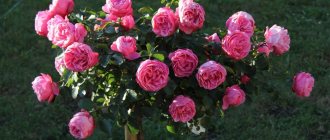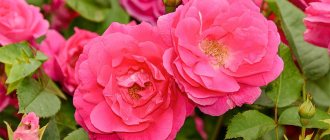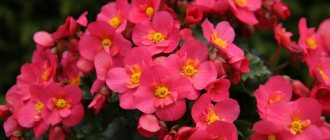Hybrid tea
An abstract rose from a bouquet that appears in our imagination will most likely belong to this group, which already numbers about 3,000 decorative varieties.
The flowers bloom on single elastic stems 40-160 cm high, can reach 16 cm in diameter, and have a clearly defined cone-shaped core framed by numerous petals. Such roses cannot boast of an expressive aroma, they are prickly, but they account for the lion's share of turnover in the trade of fresh flowers, because tea hybrids remain fresh for as long as possible when cut.
Growing these roses in your home flower bed is not a hassle - they are resistant to diseases and common pests, but severe frosts are too much for them. For the winter, even in the middle zone, bushes have to be covered. Agrotextiles are excellent for this purpose.
The varietal diversity includes:
- Flamingo;
- Anna and Anastasia;
- Monica;
- Kerio;
- Versilia;
- Red Velvet;
- Black Magic;
- Evening Star;
- Golden Dragon;
- Nostalgia.
Chemical composition and calorie content
The energy value of tea rose petals is practically zero. It is only 5 kcal per 100 g of product. However, the fragrant buds are a real storehouse of useful substances.
Thus, tea rose petals contain vitamin C, which strengthens the immune system and regulates blood count; vitamin K, which normalizes blood clotting and helps prevent osteoporosis; B vitamins, which are responsible for energy metabolism in the body, increase resistance to viruses and bacteria, and also support the functioning of the digestive system [6].
If we talk about macro- and microelements, then the largest (and best!) part of Mendeleev’s periodic table is represented in the petals of the tea rose. They contain calcium, which is responsible for the condition of bone and dental tissue; potassium, which normalizes the activity of the heart muscle; copper, which helps cope with depressive disorders and chronic fatigue syndrome; as well as iodine, which increases the elasticity of the walls of blood vessels and normalizes the functioning of the thyroid gland. Rose petals also contain iron, which is involved in the synthesis of hemoglobin; Magnesium has a vasodilating effect, which also helps cope with stress; and selenium, which is known for its antitumor properties and takes part in the synthesis of a number of enzymes and hormones [7].
In addition, the chemical composition of tea rose petals contains zinc, phosphorus, manganese, molybdenum, vanadium and silicon. Zinc helps maintain healthy hair and nails; it is also necessary for the body to properly absorb B vitamins. Phosphorus increases cognitive abilities, participates in energy metabolism, and is responsible for the condition of muscles. Manganese takes part in the synthesis of cholesterol and is also a preventative against fatty liver and the development of diabetes. Vanadium normalizes the blood formula and also helps reduce the level of “bad” cholesterol. Molybdenum is an effective means for preventing the development of gout, as well as a participant in the synthesis of a number of vitamins and enzymes.
Also, the chemical composition of rose petals contains citric and malic acids, tannins, resins and, of course, essential oil, which has an incredibly large list of beneficial properties [8]. It can stimulate the immune system and improve the condition of the endocrine glands. Also, essential oil normalizes the state of the gastrointestinal tract, eliminating the manifestations of dysbacteriosis.
It is also useful for nervous stress, because it helps to calm down and relax, prevents migraines and cerebral vascular spasms [9].
Floribunda
It can be difficult for an ignorant person to distinguish a floribunda from a tea hybrid. Its colors are even more varied, the shape of the bushes is similar, but the stems are thinner, more flexible and lower - on average 60-80 cm. The flowers themselves are usually cup- or goblet-shaped, semi-double or double (with more than 20 petals), and the diameter is more modest - 4 -12 cm.
Floribunda is distinguished by the structure of the bush: several flower stalks extend from each stem, forming a lush inflorescence, and hybrid tea roses bloom one by one.
Representatives of this group smell even less pronounced. They are undemanding in terms of keeping conditions, but require frequent feeding for abundant flowering, which lasts from the beginning of summer until the first frost and occurs in three waves. Gardeners love floribunda precisely for its high decorative qualities.
Here are some impressive varieties:
- Maria Theresa;
- Golden Border;
- Pastella;
- Midsummer;
- Brothers Grimm;
- Papajina;
- Samba;
- Tickled Pink;
- Coco Loco;
- Leonardo da Vinci.
Grandiflora
These roses are also similar in appearance to hybrid tea roses, but their main difference is revealed by their name: the bushes reach two meters in height, and the flowers have an 18-centimeter diameter. Grandiflora also blooms several times per season, is distinguished by good health and can be covered with a light polyethylene cover for the winter, provided it is mulched.
Some breeders do not include grandiflora in a separate group of roses and consider it a variety of floribunda, because the morphology of the bushes and inflorescences is the same, the only difference is in size.
In landscape design, grandiflora acts as a parterre (forms the background of large flower beds, front gardens and mixborders) or is planted singly, as a tapeworm. The rose has received the attention of Soviet and Russian breeders, but is also popular abroad.
The most notable varieties:
- Queen Elizabeth;
- Mount Shasta;
- Samurai;
- Prominent;
- Feodosia beauty;
- Marina Steven;
- Gurzuf;
- Coral surprise;
- Professor Viktor Ivanov;
- Major Gagarin.
Garden roses
The bush can be either pyramidal or spreading. Height is from 25 to 90 cm, the stems of the group of climbing roses reach 8 m.
The bush is formed by 2 types of shoots: perennial woody main stems. Annuals are softer, covered with leaves on petioles. Both species have sharp thorns, the size and number of which depend on the type of rose.
The bud is either located at the very top of the shoot, or along the entire length. Flower sizes range from 2 to 18 cm; 3 types are determined by the number of petals:
- non-double 5-8;
- semi-double 20;
- terry 70-128 cm.
Some varieties of floribunda or hybrid tea roses have curved petals, while many others have a straight shape. Sometimes they are wavy or have jagged edges.
Rose is loved due to its richness of solid colors: white, cream, yellow, red. Also multi-colored: the edge or back side of the petal is painted in a different shade, there are even stripes and stains. Through selection, it has not yet been possible to obtain only one color - blue.
Many varieties have a strong and pleasant aroma, including citrus, fruit and spice aromas.
Leaves with teeth along the edges are elongated or rounded. The surface is matte and glossy, and the color is not only shades of green, but also blotches of bronze.
Skeletal roots, covered with bark with a diameter of 2-3 cm, go into the ground. There are also thinner, smallest branches of which are called lobes.
The connecting link between the underground part of the plant and the stems with leaves is the root collar; its size in centimeters depends on the degree of penetration into the ground:
- long 10-15;
- average 5-9;
- short 3-4.
Miniature
Let's move on from giants to little ones - dwarf or border roses grow no more than half a meter in height. The flowers are small, 2-6 cm in diameter, but perky and bright, and they are usually collected in dense inflorescences of 10-12 pieces. The color of the petals is surprising, and not only in variety. There are varieties that change colors during the warm season, for example from cream through pink to dark cherry. These roses do not smell strongly, but elegantly and delicately.
Multiflora is often kept at home in flower pots - the compact size of the bush allows this. In captivity, the plant blooms three times a year: in spring, summer and autumn.
With the help of representatives of this group, they set accents in low landscape compositions (rock gardens, rock gardens, green islands) or simply plant roses in a long row along garden paths and under hedges.
Ten interesting “babies”:
- Rud Morsdag;
- Apricot Clementine;
- Degenhart;
- Tantau Honeymilk;
- Sari;
- Jewel;
- Baby Bunting;
- Lavender Maylandina;
- Fresh Pink;
- Hummingbird.
How to plant rose bushes
Dig a hole that is wider than a shovel but as deep as the root of the seedling. Recommended sizes: width 40-50 cm, depth 50-60 cm.
Mix a handful of bone meal or superphosphate with the soil removed from the hole. Save this mixture for root filling once your rose is planted. This simple technique will help the young bush to better acclimatize to new conditions. Do not feed anything else at planting time, allow the roots to become established before the tops grow.
If the seedling is in a container, carefully remove it, slightly straighten the roots so that they begin to grow immediately after planting. Soak bare roots with water for an hour to prevent them from drying out in the ground.
Make a slide in the center of the hole from a prepared mixture of soil, bone meal or superphosphate. The mound should be high enough; if you place a seedling on top of it, the node should be just below the soil level. When the plant settles, the graft should be buried 5 cm, not deeper.
Attention! Gardeners in warm climates prefer to leave the grafting node above the ground, since the chances of the seedling freezing are unlikely. You can cover the knot with soil and it will not be damaged by frost.
In this case, there is a possibility that new shoots will appear from the roots, and not from the grafted part. Then they will have other qualities that are not characteristic of the planted variety; perhaps the initially beautiful roses will no longer bloom.
Spread the roots along the slopes of the mound. Begin filling the hole with the prepared mixture, being careful not to disturb the position of the roots. Sprinkle lightly with water and let the mixture settle. Fill the mixture again, compacting it slightly with water. Continue this until the hole you dug is completely filled.
Spill the planted bush with water; you will need 1-2 buckets, depending on the soil moisture. After the water goes deep, mulch the planting with a layer of 3-5 cm. Water at least once a week so that the seedling grows. You can know that a seedling has acclimatized by the appearance of new shoots from the blossoming buds on the branches.
Repairers
These are the ancestors of all modern bouquet and garden roses, including hybrid tea, floribunda and grandiflora. Until the mid-19th century, people could not get the thorny beauties to bloom again, but crossing the Bourbon and Chinese species allowed the dream to come true.
Remontant roses are not distinguished by a variety of palettes - they are mostly pink or red, although there are bicolors, that is, varieties with two-colored petals.
The bushes are tall, up to 2 m, upright, with powerful stems and large, densely double flowers (more than 40 petals and up to 16 cm in diameter). The aroma is expressive and deep. The first abundant flowering occurs at the end of June, and the second, scanty one, in August. For the winter, the plant must be carefully covered, and it cannot boast of resistance to diseases and pests.
List of popular remontant varieties:
- Queen of Denmark;
- Beautiful love;
- Rhine Victoria;
- Great Western;
- Boule des Neiges;
- Variegata di Bologna;
- Madame Sancy de Parabert;
- Amadis;
- Chapeau de Napoleon;
- Centifloria Muscosa.
Park
Another wonderful legacy of ancient landscape art is park, palace or ancient roses, which are cultivated wild rose hips. These are very tall (1.6-2.2 m), powerful spreading shrubs, which at 4-5 years of age cannot be trimmed without a chainsaw, that is, almost trees. Rosette, flat, spherical or cup-shaped flowers are usually grouped into inflorescences of 4-8 pieces and have a diameter of 6-10 cm.
Park roses have a thick, intoxicating aroma with honey, cinnamon and musk notes. It envelops you from all sides, complementing the picturesque picture of a blooming garden.
In this group there are single- and multiple-flowering shrubs, but all of them are unpretentious and are famous for their good health. Over the many years of their development, park roses have been able to develop resistance to pests, infection, and frost. The owner of the flower garden can only take care of timely pruning.
Examples of beautiful park roses:
- Louise Bagnet;
- Piano;
- Märchenland;
- Chinatown;
- John Franklin;
- Martin Frobisher;
- Pink Grotendorst;
- Cuthbert Grant;
- Prairie Joy;
- Ferdinand Pichard.
Rosaries
Traditional rosary layout
We will accentuate the variegation of roses with a simple splash of evergreen perennials. Refined conifers and openwork ferns will skillfully create a background for the royal buds. Their price is insignificant in comparison with such a picturesque, winning landscape.
Traditional rosary
- The front part is covered with ground cover miniature plants, forming a fragrant colorful carpet.
- We will populate the middle line with colorful floribunda bushes or hybrid tea bushes 90 - 130 cm high.
- Tall climbing pink trees are solo plants: they should also stand out with the brightness of their petals. For stability, we will dig a stake 10 cm from the trunk on the windy side and tie tall pink lashes to it.
- An elastic fastening for tying up plants will simplify the care of the crown.
Note! Greenhouses and rose gardens heated by electricity are magnificent even in cold weather, and renting a diesel generator for a summer residence is beneficial because it is not expensive.
- The backdrop of the rose garden is formed by a climbing rose, which on supports will reach 5 meters. The variety of this beauty is a climbing one, and it itself is well supported on a support.
Hedge
There is nothing more beautiful than a hedge of climbing roses.
- Rose bushes picturesquely frame the site or its individual zones: a cozy utility courtyard and a charming island for relaxation. A single-row “border” in the garden will be laid by meter-long bushes, the distance between which is up to half a meter.
- With a multi-row, two- or three-tiered fence, we will plant low plants in front and further in a checkerboard pattern, but strictly in height to the last one and a half meter giants.
- 2-year-old bushes are good for hedges in a summer cottage.
Advice! The last row should not be closer than half a meter to a permanent fence or wall in order to maintain free ventilation of the plants, suppressing mold and mildew.
Climbing
One such plant can stretch 6 meters, and its stems are flexible, so support is needed. Climbing roses are used for vertical gardening, creating cozy gazebos and arches, decorating pergolas, trellises and porches of country houses.
The species is divided into two subgroups:
- Ramblers are small (2-6 cm), usually double roses, blooming once, but for a long time and require support, preferably cellular.
- Climbers are large-flowered (4-10 cm) roses up to 4 m high, which can rest on a wall or pole and bloom repeatedly.
Climbing or climbing roses require careful care: timely pruning, double application of mineral fertilizers, and for the winter, bending most varieties to the ground and covering them with non-woven material.
The most interesting representatives of the group:
- Rosarium Uetersen;
- Perennial Blue;
- William Shakespeare 2000;
- Golden Celebration;
- Pomponella;
- Bobby James;
- Iceberg;
- Gloria Day;
- Don Juan;
- Santana.
Ground cover
This group is one of the most numerous and varied in color. Low-growing varieties rise above the ground surface by only 16-20 cm and cover it with a variegated thick carpet up to 2 m wide, while tall varieties reach one and a half meters. On one such bush, up to 180 double or semi-double buds, collected in inflorescences of 20 or more pieces, can simultaneously bloom.
Ground cover roses can be cultivated at home. They look especially beautiful hanging from a flowerpot or spread out on a windowsill.
These plants bloom once, but for a long time - throughout the warm season, and individual brushes bloom at different times, which allows the bush to always look elegant and lush. Even a novice gardener can handle caring for ground cover roses, because they are undemanding and have excellent immunity.
Ten best options for a front garden or alpine hill:
- Bonica;
- Sunny Rose;
- Hello;
- Scarlett;
- Amber Sun;
- Fairy;
- Popsicle;
- Candia Mailandecor;
- Stadt Rum;
- Swanee.











